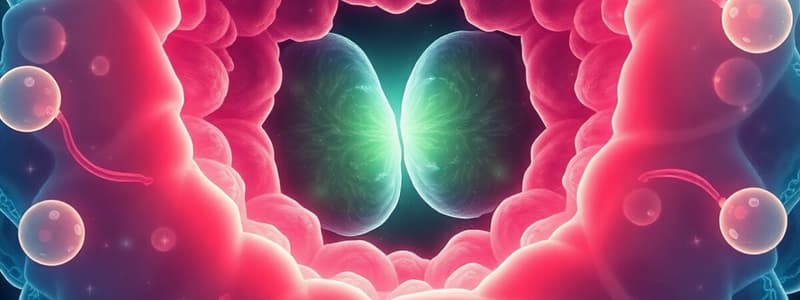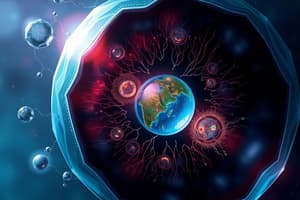Podcast
Questions and Answers
What effect does cell division have on the surface area-to-volume ratio of a cell?
What effect does cell division have on the surface area-to-volume ratio of a cell?
- It increases the ratio. (correct)
- It decreases the ratio.
- It only affects the volume, not the surface area.
- It has no effect on the ratio.
What is the primary purpose of asexual reproduction?
What is the primary purpose of asexual reproduction?
- To create offspring that need parental care.
- To produce a limited number of offspring.
- To produce genetically identical offspring from a single parent. (correct)
- To produce genetically diverse offspring.
During which phase does DNA replication occur in the cell cycle?
During which phase does DNA replication occur in the cell cycle?
- M phase
- G1 phase
- S phase (correct)
- G2 phase
Which of the following phases is NOT part of mitosis?
Which of the following phases is NOT part of mitosis?
What is the role of histone proteins?
What is the role of histone proteins?
What happens to the amount of DNA in a cell during the M-phase?
What happens to the amount of DNA in a cell during the M-phase?
Which type of cellular organism utilizes binary fission for reproduction?
Which type of cellular organism utilizes binary fission for reproduction?
What occurs during interphase in a cell?
What occurs during interphase in a cell?
What occurs during prophase of mitosis?
What occurs during prophase of mitosis?
Which process is responsible for the formation of haploid cells?
Which process is responsible for the formation of haploid cells?
During which stage of meiosis do homologous chromosomes separate?
During which stage of meiosis do homologous chromosomes separate?
What characterizes the daughter cells produced by meiosis compared to those produced by mitosis?
What characterizes the daughter cells produced by meiosis compared to those produced by mitosis?
How does crossing over during prophase 1 of meiosis contribute to genetic variation?
How does crossing over during prophase 1 of meiosis contribute to genetic variation?
What is the main difference between autosomes and sex chromosomes?
What is the main difference between autosomes and sex chromosomes?
What is the primary function of centrioles in cell division?
What is the primary function of centrioles in cell division?
In human cells, what is the ploidy of somatic cells?
In human cells, what is the ploidy of somatic cells?
What results from telophase 2 of meiosis?
What results from telophase 2 of meiosis?
What is a cleavage furrow?
What is a cleavage furrow?
Flashcards
Cell Size Limits
Cell Size Limits
The surface area-to-volume ratio decreases as cells get larger, impacting the cell's ability to exchange materials with the environment.
Cell Division
Cell Division
The process where a cell divides into two new daughter cells, crucial for growth, development, and repair in multicellular organisms and reproduction in unicellular ones.
Asexual Reproduction
Asexual Reproduction
The creation of genetically identical offspring from a single parent, often a quick and simple method of reproduction.
Binary Fission
Binary Fission
Signup and view all the flashcards
Interphase
Interphase
Signup and view all the flashcards
Chromatin
Chromatin
Signup and view all the flashcards
Mitosis
Mitosis
Signup and view all the flashcards
Cytokinesis
Cytokinesis
Signup and view all the flashcards
Prophase
Prophase
Signup and view all the flashcards
Metaphase
Metaphase
Signup and view all the flashcards
Anaphase
Anaphase
Signup and view all the flashcards
Telophase
Telophase
Signup and view all the flashcards
Haploid
Haploid
Signup and view all the flashcards
Diploid
Diploid
Signup and view all the flashcards
Mitosis vs. Meiosis
Mitosis vs. Meiosis
Signup and view all the flashcards
Gametes
Gametes
Signup and view all the flashcards
Crossing over
Crossing over
Signup and view all the flashcards
Study Notes
Cell Size and Division
- Cell size is limited by the surface area-to-volume ratio. A smaller ratio limits the cell's ability to exchange materials efficiently.
- Cell volume determines the cell's needs and waste production.
- Surface area is the contact point for exchange of materials like oxygen, nutrients, and waste. More surface area allows for quicker exchange.
- Cell division solves the problem of size limitations creating two smaller cells.
- Cell division allows for growth, repair, and reproduction (in single-celled organisms).
- Daughter cells are created after cell division, genetically identical to the parent cell.
Asexual Reproduction
- Asexual reproduction creates genetically identical offspring from a single parent. It's a faster method for producing a large number of offspring.
- Prokaryotes use binary fission to reproduce asexually (one cell splits into two).
Interphase
- Interphase is the longest stage in the cell cycle, encompassing when the cell is not actively dividing. Interphase includes three phases:
- G1 phase: Cell growth and preparation for DNA replication occurs.
- S phase: DNA replication happens.
- G2 phase: Additional cell growth and preparation for mitosis occurs.
- During interphase, the cell synthesizes proteins and grows, and the nucleus is visible.
- DNA amount & interphase: Initially, DNA amount is determined in G1, replication doubles it in S, and stays constant in G2; mitosis decreases the amount of DNA in the nucleus to original. (initial amount)
Chromatin and Chromosomes
- Chromatin: DNA and associated proteins in an unpacked state, important for gene expression and DNA replication.
- Chromosomes: Condensed chromatin, essential for movement during cell division.
- Histones are proteins that organize chromatin.
- Nucleosomes: DNA wrapped around histone proteins.
Mitosis
- Mitosis is the process of nuclear division (dividing of the nucleus). Parts of mitosis include:
- Prophase
- Metaphase
- Anaphase
- Telophase
Prophase
- Chromatin coils tightly into chromosomes.
- Chromosome consists of two sister chromatids.
- Sister chromatids contain identical DNA copies.
- Centrioles move to opposite poles of the cell.
- Spindle fibers form and connect to chromosomes at their centromeres.
- Nuclear envelope breaks down.
- Centrioles: Protein structures that organize the spindle apparatus.
- Spindle fibers: Proteins forming the spindle apparatus to organize and separate chromosomes.
- Nuclear Envelope: The membrane surrounding the nucleus; it breaks down during prophase.
Metaphase
- Chromosomes align at the cell’s equator.
- Metaphase plate: Equatorial location of chromosomes during Metaphase.
Anaphase
- Chromosomes separate at the centromeres.
- Chromatids separate becoming individual chromosomes.
- Chromosomes move to opposite poles.
Telophase
- Chromosomes reach opposite poles.
- Nuclear envelope reforms around each cluster.
- Chromosomes begin to uncoil.
- Spindle apparatus breaks down.
Cytokinesis
- Cytokinesis completes cell division by splitting the cytoplasm.
- Cleavage furrow: The indentation in the animal cell membrane that leads to its separation.
- Cell plate: The structure that forms in plant cells and develops into the cell wall during cytokinesis.
Cell Cycle Regulation and Cancer
- Regulator proteins control cell growth and division.
- Cancer is uncontrolled cell division due to lack of cell regulation.
- Unregulated cell division causes uncontrolled growth in cancer cells
Chromosomes
- Chromosomes vary in size, centromere position, staining patterns, and types of genes.
- Ploidy describes the number of chromosome sets in a cell.
- Haploid, (1N) cells have one chromosome set.
- Diploid, (2N) cells have two chromosome sets.
Humans
- Humans have 23 pairs of chromosomes (46 total) in somatic cells.
- Somatic cells are body cells, while gametes are sex cells with (23 chromosomes) (haploid).
- Autosomes are chromosomes other than the sex chromosomes.
- Sex chromosomes determine sex (XX = female; XY = male).
- Humans have 23 pairs of Chromosomes, all but one pair determine characteristics, not sex.
Meiosis
- Meiosis creates haploid gametes for sexual reproduction. This is a two-part cell division process.
- Meiosis is a Special type of cell division producing genetically different cells. Homologous chromosomes: Chromosomes that are alike in size and shape, but may carry different alleles.
Meiosis Stages
-
Meiosis I: Separates homologous chromosomes.
- Prophase I: Homologous chromosomes pair up (synapse) and exchange segments of DNA (crossing over).
- Metaphase I: Tetrads align at the cell’s equator.
- Anaphase I: Homologous chromosomes separate.
- Telophase I and Cytokinesis: Two haploid daughter cells are formed.
-
Meiosis II: Separates chromatids, similar to mitosis.
- Prophase II: Chromosomes condense and spindle forms.
- Metaphase II: Chromosomes align at the equator.
- Anaphase II: Sister chromatids separate.
- Telophase II and Cytokinesis: Four haploid daughter cells are produced.
Gamete Formation
- Males produce four equal-sized haploid sperm cells.
- Females make one large ovum (egg) and three smaller polar bodies (cells).
Fertilization
- Fertilization: Fusion of male and female gametes to produce a zygote.
- Zygote: A fertilized egg (diploid).
- Embryonic development: Zygote undergoes mitosis to form embryos.
Genetic Variation in Meiosis
- Meiosis generates genetic variation through:
- Crossing over
- Independent assortment (random alignment of chromosomes)
- Random segregation of homologous chromosomes during anaphase I
Mitosis vs Meiosis
- Mitosis produces two diploid, genetically identical cells for growth and repair. (somatic)
- Meiosis produces four haploid, genetically distinct cells for sexual reproduction. (gametes/sex cells)
Studying That Suits You
Use AI to generate personalized quizzes and flashcards to suit your learning preferences.




